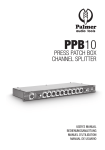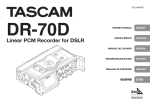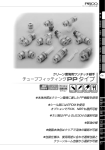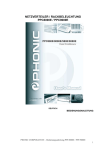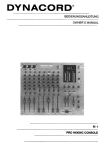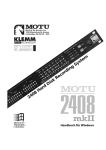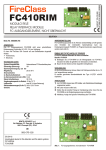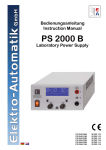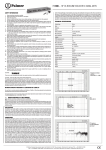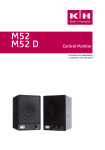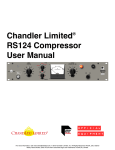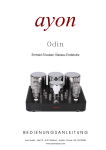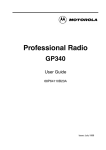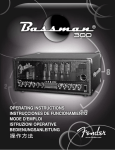Download PALMER - PPB10
Transcript
English/German PALMER - PPB10 PRESS PATCH BOX 10 - Channel splitter 10 - Kanal Audiosignalverteiler USER MANUAL BEDIENUNGSANLEITUNG AUFGABE Eine Press Patch Box ist ein spezieller Audiosignalverteiler, der ein vorhandenes Ausgangssignal auf eine Vielzahl von Ausgängen verteilt. Einen typischen Anwendungsfall stellt eine Pressekonferenz dar, wo Informationen durch einen Sprecher an viele Journalisten gerichtet werden. Damit nun nicht jeder der Medienvertreter sein individuelles Mikrofon aufbauen muß und es zu einem „Gerangel um die besten Plätze” kommt, kann das Signal eines einzigen Mikrofons über die Palmer Press Patch Box auf eine Vielzahl von Ausgängen entsprechend verteilt werden. AUSSTATTUNG Die PPB10 besitzt einen trafosymmetrischen Eingang für Linesignale. Mechanisch ist er als XLR/f Buchse sowohl auf der Frontseite wie auch auf der Rückseite vorhanden. Eine parallele Benutzung wird nicht empfohlen. Neben der rückwärtigen Buchse beÞndet sich ein Ground-Lift-Schalter, der den Pin 1 beider XLR-Buchsen von der Masse freischaltet. Über den Pegelsteller rechts neben der frontseitigen Eingangsbuchse kann die Verstärkung von maximaler Dämpfung auf +25dB eingestellt werden. Eine 5-teilige LED-Kette gibt Auskunft über die Höhe des Ausgangssignals. Bei 0dB Anzeige hat das Ausgangssignal einen Pegel von +6dBu unbelastet, bei Abschluss mit 600 Ohm sinkt der Pegel auf +4dBu. Die PPB 10 verfügt über 10 symmetrische Ausgänge, die mechanisch als XLR/m-Buchsen auf der Frontseite angeordnet sind. Alle 10 Ausgänge sind galvanisch durch Übertrager isoliert. Um eine Beeinßussung der Ausgänge untereinander auszuschließen, wird für jeweils ein benachbartes Paar eine sehr niederohmige Treiberschaltung eingesetzt, die einen Ausgangsübertrager mit zweifacher Splitwicklung speist. Gegeneinander wird ein solches Ausgangspaar mit Widerständen entkoppelt. Im Kurzschlussfall eines Ausgangs wird daher allenfalls ein Nachbarkanal um ca. 3dB gedämpft, alle übrigen Ausgänge bleiben absolut unbeeinßusst. Die Ausgänge können individuell über einen GND-Lift-Schalter, der sich auf der Rückseite beÞndet, erdfrei geschaltet werden. PPB10 KASKADIEREN Um die Anzahl von Ausgangskanälen zu erweitern, können mehrere PPB10 miteinander kombiniert werden. Dazu dienen die rückseitigen BUS IN/BUS OUT Buchsen. Vom „Master“, also dem Gerät, das das Eingangssignal liefert, wird die BUS OUT Buchse mit der BUS IN BUCHSE des zweiten Gerätes verbunden. An der BUS Out Buchse dieses Gerätes können Sie dann das nächste Gerät anschließen. Benutzen Sie als Verbindungskabel ein abgeschirmtes Mono-Klinkenkabel. Die BUS OUT Buchse eines Gerätes kann auch als zusätzlicher unsymmetrischer Ausgang genutzt werden. Bei 0dB Anzeige beträgt die Ausgangsspannung 0dBu. KOPFHÖRER Zur akustischen Überwachung des Eingangssignals ist ein Anschluss für Kopfhörer vorhanden. Die 6.3mm Stereobuchse auf der Frontseite ist so verschaltet, dass sich ein Monosignal L/R auf beiden Kapseln ergibt. (Tip und Ring der Klinkenbuchse sind miteinander verschaltet). Falls Sie den Kopfhörerausgang anderweitig belegen, achten Sie unbedingt darauf, dass kein Monoklinkenstecker benutzt wird, da in diesem Fall über den Schaft des Steckers ein Teil der Ausgangsspannung kurzgeschlossen würde. Alle Kopfhörer mit Impedanzen von 8 bis 200 Ohm können angeschlossen werden. Die Lautstärke lässt sich über das nebenan beÞndliche Potentiometer in weiten Grenzen einstellen. STROMVERSORGUNG Die PPB 10 wird über ein eingebautes Netzteil aus dem 230/240V Netz versorgt. Eine IEC Netzbuchse mit integriertem Sicherungshalter ist auf der Rückseite des Gehäuses vorhanden. Daneben beÞndet sich der Netzschalter. Eine rote LED auf der Frontseite zeigt an, ob das Gerät eingeschaltet ist. Zwischen Netzschalter und den individuellen Ground-Lift-Schaltern der Kanäle beÞndet sich ein weiterer horizontal angeordneter Erdungsschalter. Dieser Schalter verbindet/trennt die Elektronikmasse vom Gehäuse. Das Trennen der Elektronikmasse vom Gehäuse beseitigt z.B. in 19“ Geräteschränken oft gefürchtete Masseschleifen. Der gelb/grüne Schutzleiter PE ist jedoch vorschriftsmäßig immer mit dem Gehäuse verbunden. TECHNISCHE DATEN Eingänge: Trafosymmetrisch für Linepegel, XLR/f Parallelbuchsen auf Front- und Rückseite mit Ground-Lift-Schalter, Nominelle Impedanz 10k Ohm Nomineller Eingangspegel: 0dbu, maximal +20dBu Maximale Verstärkung zum Ausgang: 25dB Ausgänge: 10 trafosymmetrische Ausgänge XLR/m mit GND-LIFT-Schalter Nomineller Ausgangspegel +4dBu bei 600 Ohm Last und 0dB LED-Anzeige Nominelle Ausgangsimpedanz: 300 Ohm Kopfhörerausgang: 6.3mm Stereoklinke, Tip und Ring mono verschaltet Für Kopfhörer von 8 bis 200 Ohm geeignet, Lautstärke kontinuierlich einstellbar. 5 stuÞge LED-Kette -12dB, -6dB, 0dB, +3dB, +6dB zur Überwachung des Ausgangspegels, BUS- Ein- und Ausgang über Monoklinke zur Erweiterung der Anzahl der Ausgänge. Stromversorgung 230/240VAC (andere auf Anfrage), max. Leistungsaufnahme 10 Watt. Mechanisch: 19“-Stahlblechgehäuse 1 HE ca. 205mm tief, GEWICHT: 4Kg PALMER - PPB10: User Manual Page 2 KOMPONENTEN 7 2 3 5 4 1 6 11 9 8 10 12 13 14 01) Lineeingang 02) Pegelanzeige Ausgangspegel 03) Eingangspegelsteller 04) 10 Splitausgänge 05) Kopfhörerlautstärke 06) Kopfhörerausgang 07) Power LED 08) Netzstecker mit Sicherung 09) Netzschalter 10) Verbindet/trennt die elektronische Erde mit/von der Gehäuserde 11) Ground Lift Schalter für die Ausgänge 12) Bus verbindung um mehrere PPB10 oder PPB20 zu kaskadieren 13) Ground Lift für den Eingang 14) Paralleler Lineeingang PALMER - PPB10: User Manual Page 3 INTRODUCTION The PPB10 is a special kind of audio splitter in that it splits one incoming signal up to twenty outputs (as opposed to the usual three). This splitter is especially intended for press conferences, in which a speaker addresses a number of journalists. Instead of each journalist having to place his or her own microphone in front of the speaker, the PPB10 splits up the signal of one microphone up to twenty outputs. FUNCTION The PPB10 is comes with a transformer balanced input for line signals. Mechanically the input is equipped with Neutrik XLR/f sockets on the front as well as on the rear of the device. We do not advise a simultaneous use of both inputs. A ground lift switch is located next to the XLR input on the rear, this switch disconnects the pin 1 of both input XLRs from ground. You can adjust the input gain with the gain pot next to the front XLR input, the gain ranges from -! to +25dB. The 5-segement LED meter helps you monitor the output level. When this meter indicates 0dB the output level reads +6dBu without a load connected and +4dBu with a load of 600Ohms. The PPB10 offers 10 balanced outputs which are located on the front of the device in form of Neutrik XLR/m sockets. All 10 outputs are galvanically isolated by the use of transformers. To avoid interferences between the individual channels , 5 low ohmic driver circuits are used to drive 5 transformers, each of which split up the input signal to two outputs. The output pairs coming from each transformer are decoupled from each other by the use of resistors. In case of a short circuit on an output, only one other channel will be affected in that it is dampened by 3dB. All other channels remain completely unaffected. Each output has its individual ground lift switch on the rear of the device. CASCADING THE PPB10 To increase the number of output channels you can cascade numerous PPB10. For this application, the unit has been equipped with BUS IN/BUS OUT connectors on the rear. Simply connect the BUS OUT of the Þrst device (which is connected to the source signal) to the BUS IN of the second device. The BUS OUT of the second device can then be connected to the BUS IN of a third device and so on. Use a shielded cable with mono jacks to make these connections. The BUS OUT can also be used as an 11th split output. Here the output reads 0dBu when the meter on the front shows 0dB. HEADPHONES To acoustically monitor the input signal you can connect a pair of headphones to the PPB20. The ¼” TRS jack socket on the front is connected in such a way, that the mono input signal can be heard equally on both sides of the headphones (the tip and ring of the jack socket are connected together). Should you use this output for other purposes, make sure not to use a mono jack connector since the shaft of the connector will short a part of the output voltage. All headphones with impedances from 8 to 200 Ohms can be connected. The headphone volume can be adjusted via the volume pot next to the headphone connector. POWER SUPPLY The PPB10 is powered by an internal 230 Volt power supply. Power connector, fuse compartment and power switch can be found on the rear of the device. A red LED on the front indicates that the device is turned on. A horizontally mounted ground switch is allocated between the power switch and the individual ground lift switches on the rear. The switch connects/disconnects the electronic ground from the housing of the unit. A disconnection makes sense to avoid ground loop humming when the unit is Þtted into a 19” rack together with other mains powered devices. The yellow/green PE grounding connector however remains connected according to the regulations. SPECIFICATIONS Inputs XLR/f parallel connectors on the front and rear - transformer balanced, ground lift switch. Nominal impedance 10kOhms Nominal input level: 0dBu, max. +20dBu Max. ampliÞcation to the outputs: 25dB Outputs: 10 transformer-balanced outputs XLR/m with ground lift switch. Nominal output level +4dBu at 600Ohms load and 0dB LED meter Nominal output impedance: 300Ohms Headphone output: 6,3mm (1/4”) stereo jack, tip and ring connected together Suitable for headphones from 8 to 200Ohms, volume steplessly variable 5 segment LED chain: -12dB, -6dB, 0dB, +3dB, +6dB. To monitor the output level Bus in and out via mono jack to connect several units Power supply 230/240VAC, max power consumption 10Watts Mechanical 19”, 1U Steel housing 205mm deep Weight: 4Kg PALMER - PPB10: User Manual Page 4 COMPONENTS 7 2 3 5 4 1 6 11 9 8 10 12 13 14 01) Line input 02) 5 segment meter, output level 03) Input gain 04) 10 split outputs 05) Headphones volume 06) Headphone output 07) Power LED 08) Fuse and mains connector 09) Power switch 10) Connects electronic ground to chassis ground 11) Ground Lift switches for the outputs 12) Bus connections for linking numerous PPBs 13) Ground Lift for the inputs 14) Parallel line input PALMER - PPB10: User Manual Page 5 CURVE PLOTS Frequency & Phase Response Line Input to Output Source: 0dBu/600 Ohms Load: 200k Ohms Total Harmonic Distortion (THD) Line Input to Output Source: 0dBu/600 Ohms Output Level: +6dBu PALMER - PPB10: User Manual Page 6






